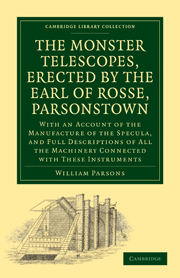 The Monster Telescopes, Erected by the Earl of Rosse, Parsonstown
The Monster Telescopes, Erected by the Earl of Rosse, Parsonstown Published online by Cambridge University Press: 01 March 2011
Lord Rosse having satisfied himself by experiments with lenses that the Refracting Telescope could not be much improved, turned his attention to Reflectors; and as the first object of experimenters had always been to increase the magnifying power and light by the construction of as large a mirror as possible, so was it to this point that his Lordship's attention was also directed.
Previous to his experiments, there had not been any instrument constructed, with the exception of Sir W. Herschell's, which had given an opportunity of sufficiently well enjoying the advantage of the Reflecting Telescope; and even of this it has been lately stated, that it possessed but little, if any, practical superiority over others of smaller size.
Since Newton manufactured his Specula until the present day, there have been several opinions both as to the metals to be employed in their construction, and the quantities in which they should be mixed—some have recommended various proportions of tin and copper; some have added arsenic; some silver; some antimony; and others, the three together—the general aim of all the operators being to increase the whiteness, and to diminish the porosity and brittleness of the compound; for the last named property has destroyed a much greater number of Specula than it has allowed to be completed—it is the “asses' bridge” over which few have been fortunate enough to travel.
To save this book to your Kindle, first ensure [email protected] is added to your Approved Personal Document E-mail List under your Personal Document Settings on the Manage Your Content and Devices page of your Amazon account. Then enter the ‘name’ part of your Kindle email address below. Find out more about saving to your Kindle.
Note you can select to save to either the @free.kindle.com or @kindle.com variations. ‘@free.kindle.com’ emails are free but can only be saved to your device when it is connected to wi-fi. ‘@kindle.com’ emails can be delivered even when you are not connected to wi-fi, but note that service fees apply.
Find out more about the Kindle Personal Document Service.
To save content items to your account, please confirm that you agree to abide by our usage policies. If this is the first time you use this feature, you will be asked to authorise Cambridge Core to connect with your account. Find out more about saving content to Dropbox.
To save content items to your account, please confirm that you agree to abide by our usage policies. If this is the first time you use this feature, you will be asked to authorise Cambridge Core to connect with your account. Find out more about saving content to Google Drive.